#nasidytes
Text

ITS TIME
FOR
DINOSAUR MARCH MADNESS 2k23!!!!!!!!!!!!
Starting NEXT WEEK, we begin the ultimate competition:
DMM: RISING STARS
These are ALL dinosaurs that have been discovered in the past five years!!! New friends from old times!!! Including such new fan favorites as Bajadasaurus, Jakapil, Meraxes, and Anachronornis - and that's only four of them!
From the weird to the wonderful, these dinosaurs are here to indicate that just because they were found recently, doesn't mean that they aren't destined to become icons like the names we already know and love. Get ready to learn about some new paleontological excitement - and debate angrily over which ones are better ;)
Round One will go from March 1st through the 7th
Round Two will extend from March 8th through the 14th
Round Three will then go from the 15th to the 21st
Round Four from the 22nd to the 28th
And the FINAL FOUR SHOWDOWN (Ornithischian Vs Sauropodomorph vs Nonavian theropod vs Bird) will occur from March 29th through April 4th!
Thanks to the new tumblr poll feature, reconstructions and mini factfiles for each dinosaur will be on the post with the poll itself! No need to leave tumblr, no personal research, no google quizzes - just rapid learning and immediate voting!
Get ready to vote! Get ready to debate! Get ready... for DINOSAUR MARCH MADNESS!
Round One Matchups under the readmore :)
SAUROPODOMORPHA (and miscellany)
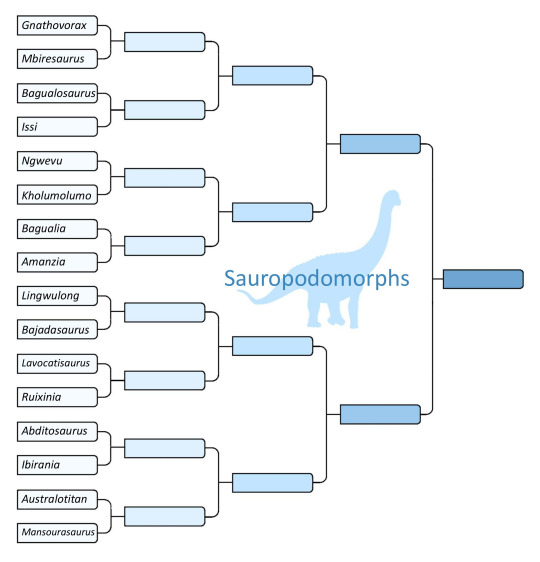
Gnathovorax vs Mbiresaurus
Bagualosaurus vs Issi
Ngwevu vs Kholumolumo
Bagualia vs Amanzia
Lingwulong vs Bajadasaurus
Lavocatisaurus vs Ruixinia
Abditosaurus vs Ibirania
Australotitan vs Mansourasaurus
ORNITHISCHIA
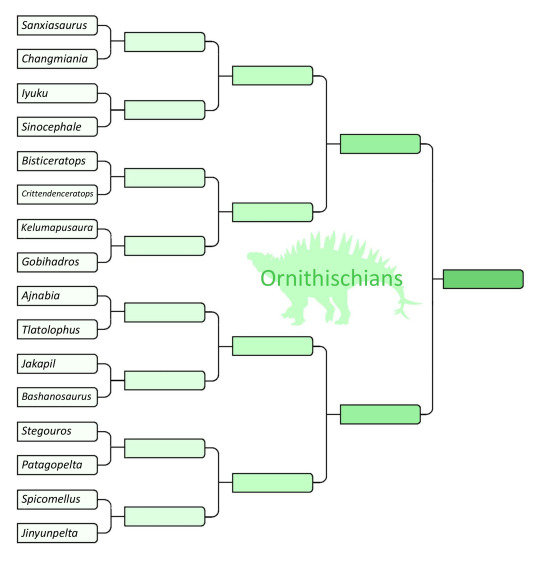
Sanxiasaurus vs Changmiania
Iyuku vs Sinocephale
Bisticeratops vs Crittendenceratops
Kelumapusaura vs Gobihadros
Ajnabia vs Tlatolophus
Jakapil vs Bashanosaurus
Stegouros vs Patagopelta
Spicomellus vs Jinyunpelta
NONAVIAN THEROPODA
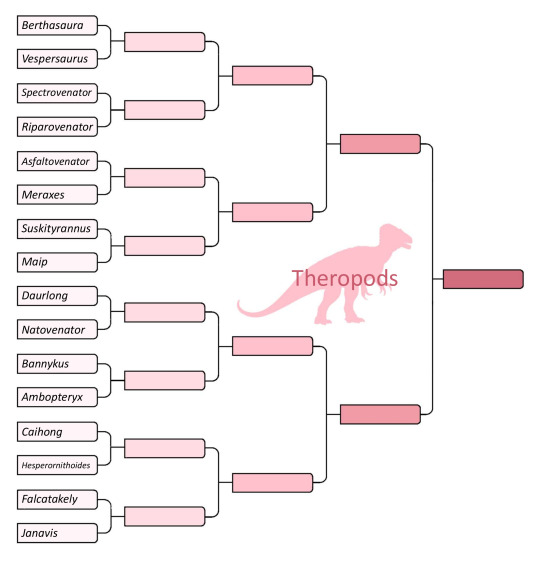
Berthasaura vs Vespersaurus
Spectrovenator vs Riparovenator
Asfaltovenator vs Meraxes
Suskityrannus vs Maip
Daurlong vs Natovenator
Bannykus vs Ambopteryx
Caihong vs Hesperornithoides
Falcatakely vs Janavis
NEORNITHES (BIRDS)

Vorombe vs Prodontopteryx
Asteriornis vs Panraogallus
Anachronornis vs Conflicto
Annakacygna vs Nasidytes
Aviraptor vs Cryptogyps
Miosurnia vs Primoptynx
Danielsraptor vs Heracles
Eofringillirostrum vs Heliothraupis
#dinosaur march madness#dmm#dmm rising stars#palaeoblr#dinosaurs#bracket#polls#march madness#tumblr dinosaur competition#thank you tumblr for making polls dmm is so much easier now I will cry#heliothraupis#eofringillirostrum#heracles#danielsraptor#primoptynx#miosurnia#cryptogyps#aviraptor#nasidytes#annakacygna#conflicto#anachronornis#panraogallus#asteriornis#prodontopteryx#vorombe#janavis#falcatakely#hesperornithoides#caihong
835 notes
·
View notes
Text
Fossil Novembirb: Day 7 - Ancient London Town
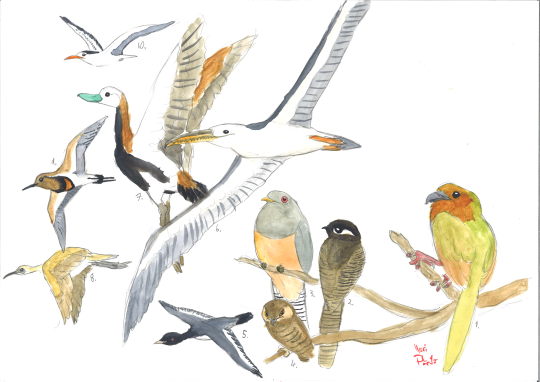
The 50 million year old fossil site of London Clay preserves impressive fossils of early Eocene birds. Back then, during the PETM, the city of London was near a tropical shoreline, and the land was covered with forests of tropical trees and palm groves. In this hot house world, birds were diversifying rapidly, and lots of strange forms lived in London Clay.
Pulchrapollia: This pretty bird belongs to a lineage related to parrots and had parrot-like feet, but was not a close relative of them. This bird had a corvid-like beak and was likely an omnivore, like jays today.
Archaeodromus: A relative of swifts, potoos and nightjars that hawked after insects, catching them in its huge mouth.
Eotrogon: An early relative of the modern trogons and quetzals. It dove after insects and fruit from its high perch.
Ypresiglaux: Among the earliest known owls, and also one of the smallest. Despite its small stature, it was a fearsome predator of insects and small vertebrates.
Nasidytes: The earliest known loon (or diver). Like its modern relatives, it was an aquatic predator of fish and invertebrates, diving beneath the surface to catch its prey.
Dasornis toliapica: A species of pelagornithid, which were large pseudotoothed soaring seabirds. This small species had a wingspan of "only" three metres.
Nettapterornis: A wading waterfowl related to modern ducks that used its long legs and flat bill to filter food from the water.
Lithornis vulturinus: An ancestral palaeognath that was perfectly capable of long distance flight. It had a flexible beak to help catch its prey.
Charadriisimilis: A small wader that was related to the same group as oystercatchers, sandpipers and plovers. It used its long legs and beak to catch small animals from the sediment.
Prophaethon: An early relative of modern tropicbirds. It could swim and fly well, and may have had a niche similar to modern gulls or terns.
#Fossil Novembirb#Novembirb#Dinovember#palaeoblr#birblr#Birds#Dinosaurs#Cenozoic Birds#Pulchrapollia#Archaeodromus#Eotrogon#Ypresiglaux#Nasidytes#Dasornis#Nettapterornis#Lithornis#Charadriisimilis#Prophaethon
46 notes
·
View notes
Text
Nasidytes ypresianus Mayr & Kitchener, 2022 (new genus and species)
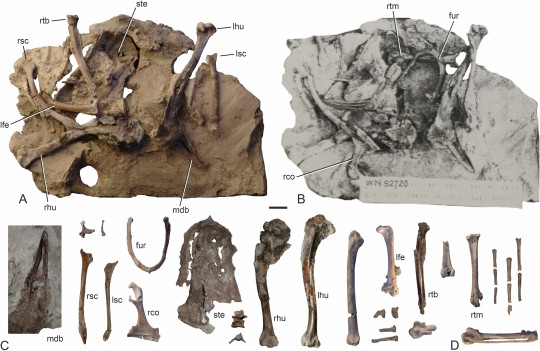
(Type specimen of Nasidytes ypresianus [scale bar = 10 mm] prior to being prepared out of the surrounding rock [A–B] and with most of the bones prepared out [C], along with an isolated carpometacarpus [fused wrist and palm bones, D], from Mayr and Kitchener, 2022)
Meaning of name: Nasidytes = nose [in Latin, referencing the type locality Walton-on-the-Naze] diver [in Greek]; ypresianus = from the Ypresian
Age: Eocene (Ypresian), 54.6‒55 million years ago
Where found: London Clay Formation, Essex, U.K.
How much is known: Partial skeleton of one individual including the lower jaw and most major limb bones. An isolated carpometacarpus (fused wrist and palm bones) has also been found.
Notes: Nasidytes was closely related to loons, a group of waterbirds from the temperate and polar regions of the Northern Hemisphere. It is the oldest and most completely known example of an early loon-like bird that has been discovered so far. (A few fossils from the Late Cretaceous have been suggested to belong to the loon lineage, but this is highly questionable.)
Modern loons are specialized for diving and hunting fish underwater, so much so that they are essentially unable to walk on land. Nasidytes, however, had a shorter, broader bill than living loons, suggesting that it did not feed mainly on fish. Although it was likely capable of swimming and diving, its hindlimbs also appear to have been less adapted to pursuing prey underwater. Instead, it may have foraged for aquatic invertebrates that did not need to be chased down.
Reference: Mayr, G. and A.C. Kitchener. 2022. Oldest fossil loon documents a pronounced ecomorphological shift in the evolution of gaviiform birds. Zoological Journal of the Linnean Society advance online publication. doi: 10.1093/zoolinnean/zlac045
43 notes
·
View notes
Text

Nasidytes
Nasidytes — вимерлий рід гагар (Gaviiformes), який мешкав у ранньому еоцені на території сучасної Великобританії. Він містить один вид, N. ypresianus. Nasidytes є найранішою однозначно ідентифікованою гагарою в літописі скам’янілостей.
Повний текст на сайті "Вимерлий світ":
https://extinctworld.in.ua/nasidytes/
#nasidytes#gaviiformes#eocene#united kingdom#great britain#birds#nasidytes ypresianus#art#loon#gavia#daily#paleoart#paleontology#extinct#prehistoric#animal art#science#creatures#illustration#fossils#bird art#палеоарт#палеонтологія#ukraine#ukrainian#україна#мова#українська мова#арт#птахи
11 notes
·
View notes
Text
Annakacygna vs Nasidytes
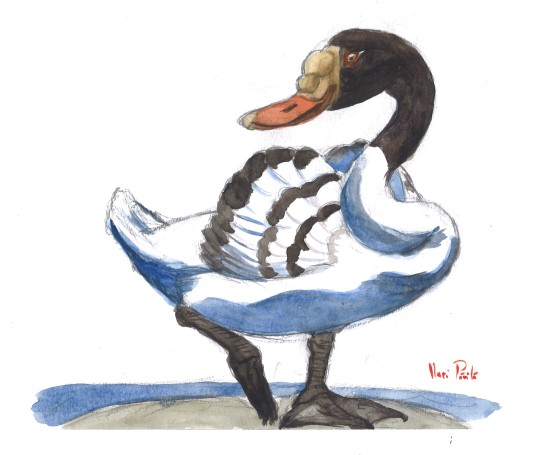

Factfiles:
Annakacygna hajimei, A. yoshiiensis

Artwork by @otussketching, written by @zygodactylus
Name Meaning: Swan from Annaka (Hajime’s or of Yoshii-machi)
Time: 11.5 million years ago (Tortonian stage of the Miocene epoch, Neogene period)
Location: Haraichi Formation, Annaka, Japan
Annakacygna was dubbed during its research “the ultimate bird”, and honestly, I don’t even blame the scientists for doing so - I may have even done the same. Both large species of swan, A. hajimei was about the size of a black swan, and A. yoshiiensis was larger than even the mute swan. They were weird in so many ways it boggles the mind: they were adapted for filter feeding in the water, their wings and tails were so flexible they could form a cradle for their young on their backs like modern mute swangs, said tails and wings were probably great and flashy display structures, its head was extremely large weird looking and had a slightly spoon-like bill, they had wide and heavy vertebrae but still had long and flexible necks, it may have even been a flightless bird or at least a poor flier based on its sternum and coracoids, though its scapula is extremely strong and unlike flightless animals - more research is needed to better understand this aspect of its mobility. That said, it did have very short wing birds, weirdly curved and short among birds, with weirdly shaped finger bones coming together to create weirdly formed curved wings. Its hips were arched up, creating a dip in its back, and it had narrow leg bones, allowing for efficient movement in the water like living *grebes and loons*. So while it had this whole weird display structure with its wings and tail going on, and its robust but long neck, and that strangely boat-shaped body (what the actual f-), it was zooming through the water like a grebe or loon. It had a similar beak to living shovelers, possibly, and it could move its jaw back and forth in a seesaw like motion, not like any living swans. It could then filter food through its jaws via this motion, eating a variety of plankton through soft lamellae within its bill. It was probably very social, given its display structures, and communicated both vocally (imagine the power of those calls with that robust neck) and visually. Annakacygna also took care of its young, extensively, keeping them on their back protected in their wings, to the point that they may not have spent much time on land (like living loons and grebes). It wasn’t a deep diver, but was stable at sea while foraging on food and moving along the surface of the water, living primarily in the ocean. Found in a marine environment, Annakacygna lived with sharks, seals, many kinds of whales, and desmostylians.
Nasidytes ypresianus

Artwork by @otussketching, written by @zygodactylus
Name Meaning: Ypresian Diver of Naze
Time: 55 million years ago (Ypresian stage of the Eocene epoch, Paleogene period)
Location: Walton Member, London Clay Formation, England
Nasidytes is the earliest known loon known via the fossil record, similar to other early fossil loons known from later times. It had a shorter and wider beak than living loons, and it had pleurocoels like most birds but unlike modern loons. It already had the weird wing proportions found in modern loons, and it had webbed feet similar to many water birds. Nasidytes probably wasn’t an aquatic pursuit predator, like its living relatives. Instead, it probably fed on marine invertebrates, making short foot-propelled dives for food. It lived near the coast, in a vibrant habitat filled with a wide variety of other early birds emerging right after the Paleocene-Eocene Thermal Maximum. The London Clay Formation was an early tropical coastal forest, much like those found in Southeast Asia today. Some of Nasidytes’ neighbors included Danielsavis, a weird duck-screamer; diurnal raptors including the masillaraptorid Danielsraptor; early relatives of owls, trogons, paleognaths, and tropicbirds; the pseudotoothed bird Dasornis; and a wide variety of parrot-passerine relatives. Crocodilians, snakes, turtles, fish, sharks, and a few mammals also lived in this environment, including an early primate Platychoerops.
DMM Round One Masterpost
#dmm#dinosaur march madness#dmm round one#dmm rising stars#palaeoblr#dinosaurs#paleontology#bracket#march madness#annakacygna#nasidytes#polls
103 notes
·
View notes
Text
ITS ALMOST FOSSIL NOVEMBIRB!!!!!
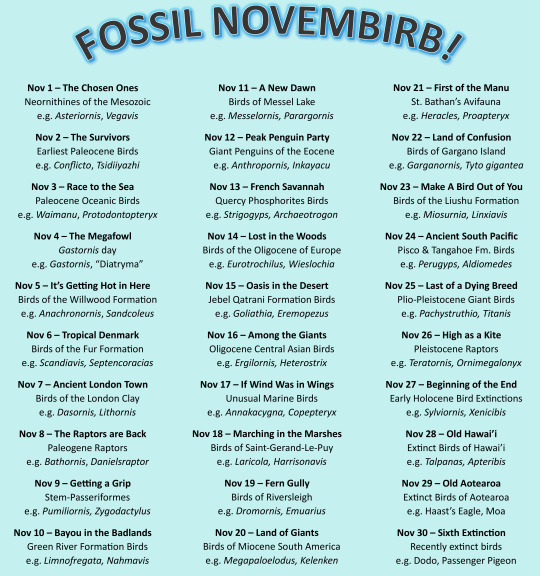
We're going to have a CELEBRATION of FOSSIL NEORNITHINES for this November!!! The extinct members of the only group of dinosaurs we have today!
Each day will have a prompt inspired by the evolution of crown-birds and the amazing forms they have taken over the past 68 million years!
You can respond to each day's prompt however you wish - with drawing and painting, writing, sculpting, music, videos, whatever! Just tag it "#Fossil Novembirb" for me to find it, and it'll get reblogged!
I'm so excited to see the art you guys create!
NOVEMBER 1 - THE CHOSEN ONES
Crown-Birds (Neornithes) known from the Mesozoic Era!
Options include Asteriornis, Teviornis, Vegavis, and "Styginetta"!
These are the only dinosaurs that survived the asteroid!
Theoretically there were also early Palaeognaths and Neoavians - if you want to do some spec evo and hypothesize what you think they might have looked like, go ahead! Follow your dreams!
NOVEMBER 2 - THE SURVIVORS
The earliest birds known after the K-Pg boundary!
Options include Conflicto, Tsidiiyazhi, Australornis, Qinornis, and Qianshanornis!
Birds diverged rapidly after the extinction, so also feel free to dive into spec evo into some of the forms we don't have fossils of!
NOVEMBER 3 - RACE TO THE SEA
The first Marine Neornithines and how they evolved in the early Paleocene!
Includes tons of early penguins like Waimanu, Kumimanu, Sequiwaimanu, Muriwaimanu, and Kupoupou
Also includes the first Pseudo-toothed bird, Protodontopteryx, and the earliest known Tropicbird, Clymenoptilon!
RISE OF THE PENGUINS!
NOVEMBER 4 - THE MEGAFOWL
Gastornis (aka "Diatryma", aka "Zhongyuanus") appeared in the mid-Paleocene and was a feature of the Cenozoic landscape until the end of the Eocene - so we have a whole day JUST FOR IT
Show your love for the Megafowl Gastornis! This giant herbivorous bird was fascinating, and has captured imaginations for decades because of it!
Gastornis is also present in many of the ecosystems described below, such as Willwood, Green River, and Messel, so we also just wanted to make sure people didn't keep picking Gastornis over and over again xD
NOVEMBER 5 - IT'S GETTING HOT IN HERE
The Paleocene-Eocene Thermal Maximum was the most dramatic incident of rapid global warming in the world since the Permian... until today!
It majorly affected the evolution of many things, possibly including birds!
The Willwood Formation straddles the time period of the warming, and has tons of birds that were evolving during that time period! So, for this day, create things involving birds of the Willwood Formation!
Options include the flighted Palaeognaths Lithornis promiscuus and Lithornis plebius; the possible stem-Ostrich Paragrus, the early half-screamer-half-duck Anachronornis, the early owl Primoptynx, and the fascinating stem-mousebird Sandcoleus! And many more!
NOVEMBER 6 - TROPICAL DENMARK
Birds of the Fur Formation, one of the best collections of bird fossils from the early Eocene!
Includes such friends as Scandiavis (an early shorebird), Septencoracias (an early roller), Pellornis (an early rail-esque thing), the utterly mysterious Morsoravis, and the early swift-hummingbird Eocypselus!
This was a tropical shoreline environment with many of the first members of major bird groups we see today!
NOVEMBER 7 - ANCIENT LONDON TOWN
Across the shore from Fur was the London Clay Formation, a lush tropical forest near the warm shallow ocean
In addition to a truly alarming quantity of plant fossils, this is a notable locality for early birds, featuring many early members of major groups much like the Fur Formation
Options include Dasornis (a pseudotoothed bird), Pulchrapollia (one of the Parrot-Passerines of Prey), Nettapterornis (another stem-duck), Nasidytes (an early loon), Charadriisimilis (an early shorebird), Archaeodromus (a trogon-like member of Strisores), Eotrogon (an actual early Trogon), Lithornis vulturinus (another flighted Palaeognath), Prophaethon (another early Tropicbird), and Ypresiglaux (an early owl) - and so many more!
NOVEMBER 8 - THE RAPTORS ARE BACK
Turns out "Predatory Feathered Thing with Really Sharp Foot Claws" is a very successful niche - not only was there potentially one right after the end of the Cretaceous (Qianshanornis), but other raptors were some of the first birds to succeed around the world in the Eocene
So this day is dedicated to the early raptors of the Cenozoic!
Any "raptor" from the Paleogene is valid - so here are some suggestions:
Early Cariamiformes (Seriemas and Kin) like Bathornis, Dynamopterus, Strigogyps, and the first potential Terror Birds like Paleopsilopterus
Early Owls like Ypresiglaux and Palaeoglaux
Early Accipitriformes like Horusornis
Early Falcons like Antarctoboenus, Masillaraptor, and Danielsraptor
And of course the ever popular "Parrot-Passerines of Prey" like Tynskya and Messelastur
NOVEMBER 9 - GETTING A GRIP
Half of all living birds are Passeriformes - aka "Perching Birds" - but this wasn't always the case! For most of Earth's history, many other kinds of tree birds were extremely common
Where did this behemoth group of tiny dinosaurs come from? That's the subject of this day's prompt!
In the Eocene, the first birds closer to Passeriformes than to Parrots evolved, and they came in a huge variety of forms! So on Nov 9th, we're going to celebrate this group's interesting beginnings!
Options for this include Parapsittacopes, Eofringillirostrum, Pumiliornis, Psittacopes, Zygodactylus, Primozygodactylus, Psittacomimus, Sororavis, Morsoravis, and Eozygodactylus! Go wild!
NOVEMBER 10 - BAYOU IN THE BADLANDS
Back to specific ecosystems! We're visiting the world-famous Fossil Lake of the Green River Formation!
This environment, during the Early Eocene, was a thriving tropical lake and forest ecosystem filled with tons of early Neornithines as well as mammals and other animals
Gorgeous fossils have come out of this lake, showing truly amazing detail of feathers and other features for these birds!
So here you can feature Prefica (a potential early Oilbird), the flighted Palaeognath Calciavis, the stem-turaco Foro, the early mousebird Celericolius, the possible shore-bird Nahmavis, a potential cuckoo roller Plesiocathartes, the Flamingo-Duck Presbyornis, the early landfowl Gallinuloides, the swift-hummingbird Eocypselus, and the Frigate Bird Trying at being a Gull Limnofregata - and so many more!
NOVEMBER 11 - A NEW DAWN
We're finally moving on to the middle Eocene - and the Messel Lake ecosystem, famous from the first episode of Walking with Beasts (hence the name of the day)!
(If you're going "wait, that episode acts like nothing happened between the K-Pg and Messel, but here you have 10 days worth of stuff" .... yeah. Walking With Beasts skipped the Paleocene and early Eocene and I am... very pissed. Still.)
You know about the tons of early mammals from this tropical lake ecosystem, but it was filled with tons of early birds as well!
There's the early ostrich Palaeotis, the crane-rail Messelornis, the almost-flamingo Juncitarsus, the freshwater Booby Masillastega, the early hoopoe Messelirrisor, Selmes (a mouse bird with stubby toes), the early ibis Rhynchaeites, the early nightbird Hassiavis, the early swift Scaniacypselus, an early roller with known colors Eocoracias, and the early potoo Paraprefica - and many others!
NOVEMBER 12 - PEAK PENGUIN PARTY
As the Eocene continued, penguins achieved true megafaunal status - there were tons of them, they were huge, and they were all over the oceans of the Southern Hemisphere
While penguin diversity never did recover after the Eocene-Oligocene extinction event, this golden age deserves celebration!
Some of these fascinating peak penguins include Palaeeudyptes, Anthropornis, Icadyptes, Inkayacu, Perudyptes, and Kairuku!
NOVEMBER 13 - FRENCH SAVANNAH
As the Eocene began to dry up and cool down, plains grew across the world where the tropical forests once had been
One of the most famous later-Eocene fossil sites for birds is the Quercy Phosphorites location, a French formation with tons of interesting fossil birds!
Here we start to see the early forms of Neornithine Dinosaurs we saw in the Paleocene-Early Eocene diverge and specialize further - often in particularly weird or interesting ways!
So here we have the duck-ish chicken Paraortyx, the secretarybird Pelargopappus, you can also bring back Dynamopterus from earlier, there is the stem-chicken Quercymegapodius as well as stem-parrots like Quercypsitta, the seriema-like Strigogyps, the sandgrouse relative Archaeoganga, Archaeotrogon shows up again, the swift relative Aegialornis, a potential woodpecker relative Sylphornis, and more owls like Palaeoglaux! Lots of cursorial predators in this ecosystem!
NOVEMBER 14 - LOST IN THE WOODS
As the Oligocene dawned, forests did grow back in Europe, though they were now temperate and dry as opposed to the paratropical rainforests of before
This lead to wide diversification of tree-dwelling birds, and so here we will celebrate the birds of the Oligocene of Europe!
We start to really see modern-esque birds at this point, though of course we still have 30 million years of evolution to go!
Here you can feature the early eagle/hawk Aviraptor, the European Hummingbird Eurotrochilus, the seabird relative Rupelornis, the early woodpecker-toucan Rupelramphastoides, the tody Palaeotodus, the proper Passerine Wieslochia, the possible shorebird Turnipax, the mousebird Oligocolius, the hoopoe Laurillardia, and the trogon Primotrogon which we know the colors of!
NOVEMBER 15 - OASIS IN THE DESERT
The Jebel Qatrani Formation of Egypt shows the beginnings of the famous African Grassland animals, as well as many early members of iconic African animal groups such as primates - and, of course, birds!
Taking place in the early Oligocene, this formation was a tropical/subtropical lowland plain filled with ponds and streams and other waterways - aka, tons of swamps surrounded by plains
As such, this place is infested with waterbirds!
Here we have a fossil relative of the Shoebill Goliathia, as well as the jacanas Janipes and Nupharanassa, the giant stork Palaeoephippiorhynchus, the herons Nycticorax and Xenerodiops, and the mystery Palaeognath Eremopezus!
NOVEMBER 16 - AMONG THE GIANTS
Once again we're just fully committing to the Walking With Beasts nostalgia bc these are the birds we wish were in it more okay we said it
Anyways there were some interesting large birds in the plains of the "Land of Giants" episode so picture these guys alongside the Indricothere etc.
In general we're covering the latest Eocene through the Oligocene of Central Asia
Here we have the enigmatic ratites Ergilornis and Sonogrus, the pseudo-toothed bird Caspiodontornis, the owl Heterostrix, and the stem-flamingo Agnopterus
NOVEMBER 17 - IF THE WIND WAS IN OUR WINGS
We all focus on penguins, but over the Cenozoic, plenty of weird birds have evolved for marine life, and boy are they bizarre!
So for Nov 17, we're focusing on the unusual marine birds of the Cenozoic!
This includes any members of the Pelagornithids - aka the Pseudo-toothed birds - as well as the Plotopterids - the Boobies that became Penguins! Pelagornis and Copepteryx are the best known taxa from each, respectively, but there are plenty more!
But that's not all! We have the flightless auks Miomancalla and Mancalla, the large flightless marine duck Chendytes, and who can forget the weird flightless marine swan Annakacygna! Tons of options to choose from!
NOVEMBER 18 - MARCHING IN THE MARSHES
We're now starting our transition from the Paleogene into the Neogene, beginning with the brackish marsh ecosystem preserved at Saint-Gerand-Le-Puy in France!
This Miocene locality preserves a wide variety of birds that are near modern, but not quite - a sort of "uncanny valley" of bird evolution, all set in a somewhat-salty somewhat-not wetland ecosystem
Options for dinosaurs here include Harrisonavis, a transitional flamingo; the early gull/tern Laricola, the enigmatic duck Mionetta, the stork Grallavis, the pratincole Becassius, the swimming-flamingo Palaelodus, the early cormorant Nectornis, the seed-eating pheasant Palaeortyx, the early loon Colymboides, and the mysterious shorebird Elorius!
NOVEMBER 19 - FERN GULLY
Riversleigh is one of the most famous fossil sites in the world, preserving the evolution of the strange and unique animals known today in Australia, during the Oligocene to Miocene transition
Most often, we focus on the bizarre mammals found at Riversleigh, and for good reason - it's a Marsupial Party! - but the birds here are fantastic as well
This ecosystem was a rich rainforest that transitioned over the period of deposition into a semiarid grassland, and covers 20 million years of animal evolution during that transition
Options for birds here include the butcherbird Kurrartapu, the fossil Sittella Daphoenositta trevorworthyi, the Mihirungs ("Demon Ducks") Dromornis and Barawertornis, the Emuwary Emuarius, the early magpie-goose Eoanseranas, the raptor Pengana with flexible ankles, the earliest known species of lyrebird (Menura tyawanoides), the corvid-like Corvitalusoides, the first known cockatoos, the flightless rail-like bird Australlus, the stiff-tailed duck Pinpanetta, the early logrunner Orthonyx kaldowinyeri, and so many more!
NOVEMBER 20 - LAND OF GIANTS
Y'all were probably wondering when we'd get to the Terror Birds and other interesting dinosaurs of South America, so - here we are!
South America, isolated from the rest of the world until the Great American Interchange, featured a wide variety of bizarre and unique animals - not just mammals, but birds and other reptiles as well!
So for Nov 20th, we're looking at the interesting dinosaurs of the "lost continent" during the Miocene epoch, prior to the invasion of North American taxa!
Any Miocene South American Terror Bird (Phorusrachid) is fair game here, so that includes Brontornis, Patagorhacos, Paraphysornis, Devincenzia, Kelenken, Phorusrhacos, Patagornis, Andalgalornis, Psilopterus, Mesembriornis, and Procariama! Note that they did not all live at the same time or even close to each other in location, so do your research on the taxa you pick!
But Terror Birds weren't the only strange dinosaurs in South America at the time! We have the large Teratorn (vulture-like-thing) Argentavis, the *giant* swimming-flamingo Megapaloelodus, the giant Anhinga Macranhinga, the rhea Opisthodactylus, the penguins Palaeospheniscus, Arthrodytes, and Paraptenodytes, the Cathartid Dryornis, the Jacamar Galbula hylochoreutes, fossil Hoatzins like Hoazinavis and Hoazinoides, the giant stork Leptoptilos patagonicus, and the owl Yarquen!
NOVEMBER 21 - FIRST OF THE MANU
Aotearoa has one of the most unique avifaunas in the world today, and I often call it "Mesozoic 2" because of its almost entirely dinosaur-dominated fauna, especially in the past
All great things have to start somewhere or when, and for Aotearoa, that somewhen was after the landmass resurfaced from the ocean for the first time in millions of years - and was quickly inhabited by all kinds of birds and other reptiles (including tuatara) in the Miocene
This ecosystem was a lake bordered by grassy wetland floodplains and subtropical forests, a bit warmer than Aotearoa today
Dinosaurs here include the early Kiwi Proapteryx, an unnamed early Moa, a truly alarming number of waterfowl including shelducks like Miotadorna, stiff-tailed ducks like Manuherikia, and the possible swan Notochen, the small swimming-flamingo Palaelodus aotearoa, pigeons like Rupephaps and Deliaphaps, an early adzebill Aptornis proasciarostratus, flightless rails like Priscaweka, the lake-wanderer Hakawai melvillei, the herons Pikaihao and Matuku, the giant parrot Heracles, proto-keas Nelepsittacus, and the New Zealand Wren Kuiornis. Tons of fun species to choose from!
NOVEMBER 22 - LAND OF CONFUSION
In the Late Miocene to Early Pliocene, the Italian province of Gargano was cut off from the mainland due to rising sea levels, turning it into an island - an island with lots of really strange birds!
This island was cut off from everything else and completely lacked large predators, allowing for a weird variety of animals to evolve and thrive prior to the island rejoining the mainland during the Ice Age
Strange birds of this ecosystem include the extremely old pigeon Columba omnisanctorum, the giant hawk Garganoaetus, the giant flightless goose Garganornis, the giant barn owl Tyto gigantea, the pheasant Palaeortyx volans, and the swift Apus wetmorei!
NOVEMBER 23 - MAKE A BIRD OUT OF YOU
The iconic animals of the Ice Age and recent prehistory had to come from somewhere, and much of this transition is recorded in the Chinese Ecosystem of the Liushu Formation, deposited between 11 and 6.4 million years ago
As grasslands expanded, this ecosystem transitioned from a forest to a wide plains, and many animals adapted for the grasslands accordingly, leading to the appearance of such mammals as Elasmotheriines, Sabercats, Hyenas, Ambelodonts, and a truly alarming quantity of hoofed mammals
Dinosaurs (Birds) adapted to this ecosystem change as well, of course! While most focus on the mammals of Liushu, we're here to showcase the interesting birds that appeared here as well!
Options here include the the very well preserved Falcon Falco hezhengensis, the vultures Mioneophron and Gansugyps, the diurnal owl Miosurnia, the vocally fancy pheasant Panraogallus, the sandgrouse Linxiavis, the Ostrich Struthio (or Orientornis) linxiaensis, and the probable-Ostrich Sinoergilornis
NOVEMBER 24 - ANCIENT SOUTH PACIFIC
Penguins are Bouncing Back! As the Miocene continued and the Pliocene began, many new types of marine birds showed up and were fossilized in locations in Chile (Pisco) and Aotearoa (Tangahoe)
Tons of interesting birds were preserved in this sort of transitional ecosystem, showcasing how birds adapted to changing conditions as the Miocene-Pliocene climatic turmoil continued
These near shore environments are probably more famous for their other animals - things like the giant shark "megalodon", as well as weird whales like Livyatan and Odobenocetops and aquatic giant sloths (like Thalassocnus) and marine crocodilians - but we're here for those dinosaurs!
Options here from the Pisco Formation include the "Toucan-Booby" Ramphastosula, the Cathartid Perugyps, the Booby Sula figueroae, Pelagornithids, Pelicans, and the penguins Spheniscus urbinai and Spheniscus megaramphus, whereas birds from the Tangahoe Formation include the narrow-beaked albatross Aldiomedes, the giant petrel Macronectes, the more regular-sized petrel Procellaria altirostris, the little penguin Eudyptula wilsonae, and the crested penguin Eudyptes atatu!
NOVEMBER 25 - LAST OF A DYING BREED
We all love Megafuana, even though they are usually the "Live Fast Die Young" kind of species - gobbling up resources and growing too big will do that to you
Usually when we hear the term "Megafauna" we think of Mammals and Non-Avian Dinosaurs, but birds have had their share too - and have lost their share as well
So, mainly to cater to the Megafauna Fanbase, here we dedicate a whole day to the giant birds of recent times - Pliocene through Pleistocene - that we have lost to the dramatic climate change of the Ice Age Era. (Those lost in the Holocene will get their own days, see below)
Options for this day include the giant ostrich Pachystruthio, the Mihirung Genyornis, the Terror Bird Titanis, the giant stork Leptoptilos robustus, the giant swan Cygnus falconeri, the giant Anhinga Giganhinga, and of course - we can't forget our friend - the last of the Pseudotoothed Birds, Pelagornis
NOVEMBER 26 - HIGH AS A KITE
In many ways, the real dinosaur winners of the Ice Age were the flying Birds of Prey, as there were many kinds of raptors during the Ice Age and they exploited the new environment expertly
Nothing like being able to traverse huge distances to find places where there are food, amiright?
So this day is dedicated to the fantastic Raptors of the Ice Age, both volant and not!
Here we have some of the last of the Teratorns like Teratornis itself, the Giant Australian Raptor Dynatoaetus, the Australian Vulture Cryptogyps, Woodward's Eagle Buteogallus woodwardi, the tiny Condor Wingegyps, the large Cuban Eagle Gigantohierax, the wandering vulture Neogyps, the Walking Eagle Buteogallus daggetti, the Giant Cuban Stilt-Owl Ornimegalonyx, and one of the last Terror Birds, Psilopterus
NOVEMBER 27 - BEGINNING OF THE END
Oh Holocene Extinctions. As upsetting as they are, they include some of the best known fossil/subfossil birds, so we decided to spend a little extra time on them than they should have based solely on the time length
Here, we highlight the early losses of the Holocene - those dinosaurs that went extinct at the start, largely due to direct human activity such as hunting in addition to the warming caused by the end of the last Ice Age/Glacial Maximum
Days will be dedicated to both Hawai'i (see below) and Aotearoa (again, below), so this is for everyone else!
So options here include the previously mentioned marine duck Chendytes, the giant flightless landfowl Sylviornis from New Caledonia, the famous Elephant Birds of Madagascar, the flightless clubbing-ibis Xenicibis, the weird puffin Fratercula dowi, the giant Bahama Eagle Titanohierax, the Californian Turkey Meleagris californica, and the flightless "Cave Rail" Nesotrochis of the Greater Antilles
NOVEMBER 28 - OLD HAWAI'I
Many, many, MANY unique dinosaurs live on islands. The islands of Hawai'i are no exception, and these islands have lost many unique and fascinating birds over the years - thanks to human activity, invasive cats, colonialism, and climate change
We couldn't possibly ignore them, so for this day, we are hilghlighting these amazing animals found across the archipelago
There are tons of options, but some of our recommendations include the reverse-platypus/Mole Duck Talpanas, the Stilt-Owl Grallistrix, the flightless ibis Apteribis, the Moa-Nalo like Chelychelynechen, Ptaiochen, and Thambetochen, the Wood Harrier Circus dossenus, Hawai'ian Honeycreepers like Drepanis, Aidemedia, Hemignathus, Chloridops, Akialoa, Rhodacanthis, Dysmorodrepanis, Telespiza, and Vangulifer, the Oloma'o and ʻĀmaui thrushes, ʻōʻō's/Hawai'ian Honeyeaters like the Kioea, Kauaʻi ʻōʻō, and Oʻahu ʻōʻō, the giant Hawai'i Goose, the nēnē-nui/wood-walking goose, the Robust Crow, the flightless Laysan Rail, and the O'ahu Petrel
NOVEMBER 29 - OLD AOTEAROA
We're finally here: Pre-Human Holocene Aotearoa, aka Mesozoic 2, aka The Land Where Mammals Ain't Shit
I love Aotearoa so much. Why wasn't I born there. The universe isn't fair.
The ecosystems were very similar to today - podocarp forests and southern beech forests, grass and tussock plains and shrublands, and plenty of coastal habitats, all usually temperate in terms of climate
All named Moa are fair game. All of them, all named members of Dinornithiformes. So the North Island Giant Moa, the South Island Giant Moa, the Bush Moa, the Eastern Moa, the Broad-Billed Moa, the Heavy-Footed Moa, Mantell's Moa, the Crested Moa, and the Upload Moa. Follow your Moa-Filled Dreams!
Obviously there were more than Moa - not just the living species of Aotearoa still with us, but tons of other extinct forms for Fossil Novembirb. This includes the Adzebills, Haast's Eagle (of course), the whēkau/Laughing Owl Ninox albifacies, the New Zealand Goose Cnemiornis, the New Zealand Owlet-Nightjar, the mehonui Diaphorapteryx, the Long-Billed Wren Dendroscansor, the piopio Turnagra, and the Huia
NOVEMBER 30 - SIXTH EXTINCTION
And, for our last day, we cover recent Holocene extinctions (not on Hawai'i or Aotearoa) - the birds/dinosaurs we have lost in the living past, due largely to colonialism, capitalism, globalism, and climate change
Any bird extinct since 1492 not previously covered is fair game, and there are a lot of them. Today, we honor them, however we can.
Some suggestions include the Dodo (of course), the Cuban Macaw, the Pink-Headed Duck, the Northern Curlew, the Great Auk, the Passenger Pigeon, the Carolina Parakeet, the Ivory-Billed Woodpecker, the Labrador Duck, the Saint Helena Hoopoe, and the Spectacled Cormorant; though there are of course many otherse to choose from as well
Kind of a bummer note to end on, but here we are
Living Birds already get tons of time and attention, so we really don't want to include them here - we love them, but the fossils of the Neornithes world deserve love too! So we tried to cover all of the bases, as best as we could!
Remember, Wikipedia, the Paleobiology Database, The Works of Gerald Mayr, the third volume of "Earth Before Us", and the blogs of myself and @albertonykus and @otussketching are all fantastic resources to look for information about these wonderful animals! Also check out Through Time and Clades' "Dinosaurs: The Second Chapter" series and the Raptormaniacs blog from Albert as well!
HAVE FUN! CREATE WHAT YOU DREAM! AND LOVE CENOZOIC DINOSAURS!
HAPPY FOSSIL NOVEMBIRB!
#Fossil Novembirb#Novembirb#Dinovember#birblr#palaeoblr#Birds#Dinosaurs#Cenozoic Birds#Neornithines#Dinovembirb
613 notes
·
View notes
Text
Danielsraptor vs Heracles
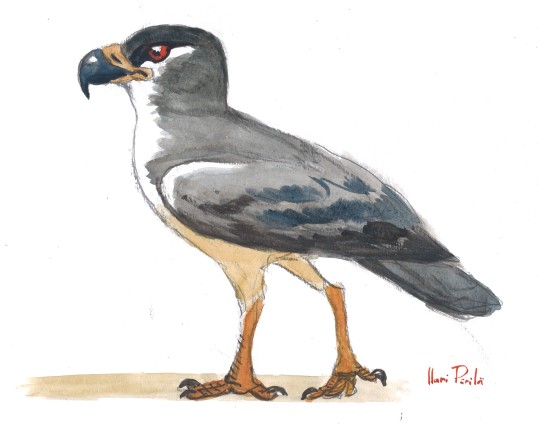

Factfiles:
Danielsraptor phorusrhacoides

Artwork by @otussketching, written by @zygodactylus
Name Meaning: Michael Daniels’ Terror Thief Bird
Time: 55 million years ago (Ypresian stage of the Eocene epoch, Paleogene period)
Location: Walton Member, London Clay Formation, England
While the Eocene fossil records of Seriemas, Passerines, and Parrots are fairly well known, the last remaining group of Australavians - the Falcons - remains something of a mystery. Danielsraptor helps to put together this puzzle a little more. Along with Masillaraptor, these birds show an early radiation of falcon-relatives from the Eocene in which they tried out a more terrestrial lifestyle! Danielsraptor had long legs, allowing it to forage and hunt on the ground like modern caracaras. It had a very large pygostyle, giving it long tail feathers - and with strong wing bones, it was able to fly in addition to hunt on the ground. It had a beak very similar to living caracaras and the extinct Terror Birds, further corroborating the idea that it was a bird of prey (and also potentially indicating a more complex evolutionary story for the early-derived Australavians). Living in the London Clay, Danielsraptor would have been one of the top predators, easily hunting the small mammals as well as the birds it shared its environment with - aided by both its terrestrial stalking abilities as well as its flying capability. Living in the London Clay, it shared its environment with the early loon Nasidytes, early owls, trogons, paleognaths, tropicbirds, duck-screamers, other diurnal raptors, the pseudotoothed bird Dasornis, and many parrot-passerine relatives. Crocodilians, snakes, turtles, fish, sharks, and a handful of mammals (including a primate) also lived in this rich post-Paleocene-Eocene Thermal Maximum environment.
Heracles inexpectatus

Artwork by @otussketching, written by @zygodactylus
Name Meaning: Unexpected Herculean Parrot
Time: 16 to 19 million years ago (Burdigalian stage of the Miocene epoch, Neogene period)
Location: St. Bathans Fauna, Bannockburn Formation, Aotearoa
Heracles was a truly alarmingly large parrot, related to modern day Kea, Kaka, and Kakapo, known from the fantastic avifauna of St Bathans. Standing more than two feet tall and weighing about fifteen pounds, this animal was much larger than any expected from the St Bathans fauna, which represented the initial colonization of Aotearoa (Zealandia) after it returned above sea level. Heracles is also the largest known species of parrot, ever. It was presumably flightless, though it is uncertain if it was nocturnal like its living relative the Kakapo. Its exact ecology is still uncertain, given the material known from Heracles is limited and its living relatives have very disparate ecologies, though it is possible it was omnivorous similar to the Kea and Kaka today. The St Bathans fauna lived in a freshwater lake system, in a subtropical emergent rainforest. Separated from land bridges, the fauna was dominated by birds, with early relatives of the Kiwi, New Zealand Wrens, Adzebills, and Wedge-Tailed eagles found in the fauna, as well as somewhat modern looking Moas. Smaller flamingos, large fruit pigeons, and a huge variety of geese and other waterfowl are known. In addition, frogs, tuataras, other lizards, crocodilians, turtles, and many different types of fish are known from this fascinating ecosystem.
DMM Round One Masterpost
#dmm#dinosaur march madness#dmm round one#dmm rising stars#palaeoblr#dinosaurs#paleontology#bracket#march madness#danielsraptor#heracles#polls
178 notes
·
View notes
Text
Fossil Novembirb 7: Ancient London Town

Halcyornis by @thewoodparable
Next on our excellent tour of Early Eocene Ecosystems is the London Clay Formation - an increasingly important location near yesterday's Fur that showcases another coastal forest of the post-PETM hothouse world. Filled with tons of fossil plants, London Clay is one of the world's most diverse localities for fossil seeds and fruits. Plus, it's lousy with dinosaurs! In fact, the first ever named fossil bird, Halcyornis, is from the London Clay!
Much like the Fur, there are just too many different kinds of birds in this ecosystem for me to talk about all of them - and more and more are being named lately, thanks to the donation of the late Michael Daniels' collection to researchers at last. There were strange ducks and owls, parrot-passerines of prey, paleognaths and loons, pseudotoothed birds and raptors, swifts and tubenoses and tropicbirds and more! Heck, even fossil cuckoo-rollers were present!

Nasidytes by @otussketching
In fact, the wide spread of many birds that today are limited to places in the southern hemisphere, such as Cuckoo-Rollers and Trogons, is a fascinating look into the radiation of Neoaves around the time of the PETM. Currently, the best hypothesis for this change is that these birds were adapted to the tropical temperatures, and when those climate bands retreated to their present positions these birds followed them. A prediction for the results of anthropogenic climate change? Who knows.
What's extra fascinating is that clearly, some birds didn't move, but just adapted to the cold - such as loons like Nasidytes above, as well as a variety of fowl and other birds. Why some birds went one way, and others another - and still others, towards extinction - remains a mystery.
But back in the Eocene, they were all hanging out together, apparently all over the place! That's what flight will get you, of course.

Dasornis by @quetzalpali-art
London Clay has a surprising amount of Pseudotoothed birds, which had been around since the Paleocene but did not become common until the Eocene. But here there were two different species - Dasornis and Odontopteryx - that were already well on their way to exploiting the marine soaring bird niche that most Pelagorns would one day inhabit.
Raptors were diversifying wildly here, too, with early relatives of falcons like Danielsraptor present and trying out a more terrestrial lifestyle than living falcons - perhaps an ancestral ecology for Australaves, given that Seriemas diverged before them! With a large curved beak and long legs, it was able to prowl the environment and hunt the scores of other birds living around it!
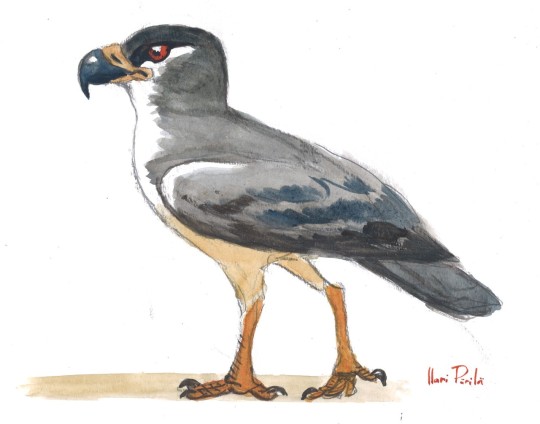
Danielsraptor by @otussketching
Lithornis was here, too, as it has been in the last two - a real staple of the PETM world, this Palaeognath was a strong flier, and was probably able to expand its territory successfully as the climate warmed around the world. The lack of Palaeognaths in North America and Europe today now seems even weirder by comparison! These birds would have used their long beaks to probe the sand and dirt for all the different sources of food hiding inside.
Early storm-petrels also showed up, alongside more tropicbirds, in the form of Primodroma and Prophaeton respectively, indicating that these kinds of shore birds not only evolved multiple times, but lived alongside each other in more of the world than they do today. Parrot-Passerines of prey, like Halcyornis and Pulchrapollia and Tynskya, were everywhere and filling the niche of tree dwelling raptors instead of things like falcons and hawks - amazing how much these dinosaurs have changed since!

Anatalavis by @quetzalpali-art
I would be remiss if I didn't bring up the ducks I helped to describe! Danielsavis was another hodgepodge duck-screamer, though less of it was preserved than Anachronornis. That said, it had a more screamer-like foot, shoulder, and jaw. With it lived Anatalavis, a bird possibly related to the living Magpie-Geese of Australia - wading birds with not much webbing and long goose-like necks. Anatalavis had a very duck-like beak, making it a filter-feeder, rather than a macrofeeder like the living Magpie-Goose. Eating on smaller animals and plants in the water, it didn't have any modern-type ducks around for competition!
Early owls were here too, like Ypresiglaux, a very small owl - weighing possibly less than 50 grams! This means that Ypresiglaux was the smallest known Owl of all history, and probably ate mostly arthropods. It also couldn't turn it's head around as much as living owls, and was possibly diurnal! Birds just kept diversifying into so many niches, it's amazing to see both the similarities and differences across so many clades.
Sources:
Collinson, M. 1983. Fossil plants of the London Clay. The Palaeontological Association 1: 1-122.
Mayr, 2022. Paleogene Fossil Birds, 2nd Edition. Springer Cham.
Mayr, 2017. Avian Evolution: The Fossil Record of Birds and its Paleobiological Significance (TOPA Topics in Paleobiology). Wiley Blackwell.
52 notes
·
View notes